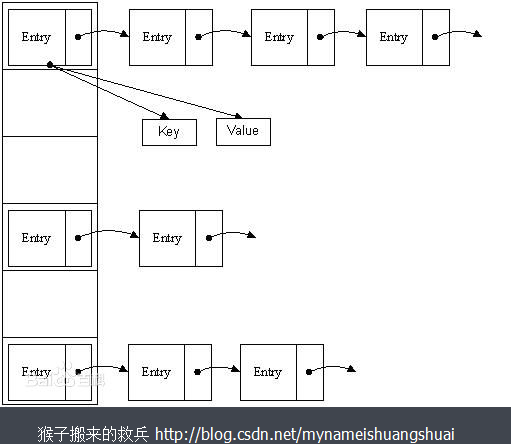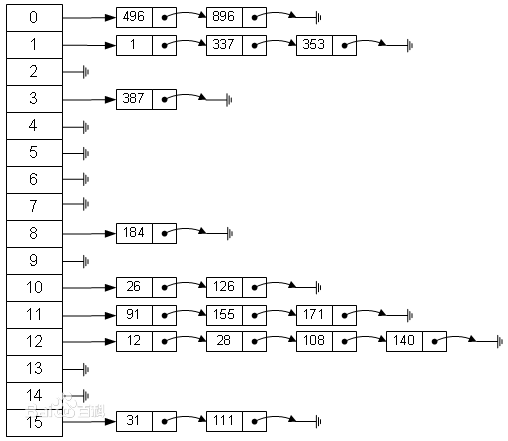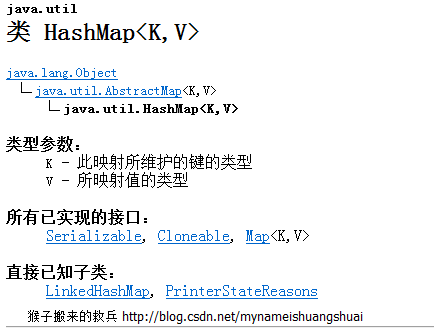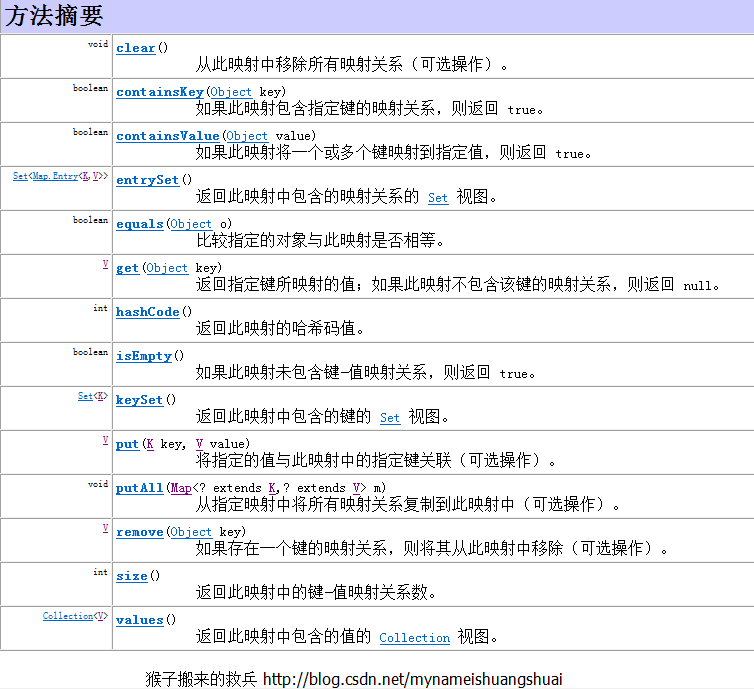线性表数据结构解读(五)哈希表结构-HashMap
2016-12-10 00:00
501 查看
前面的博客中,我给大家分析过数组和链表两种线性表数据结构。数组存储区间连续,查找方便,但是插入和删除效率低下;链表存储区间离散,插入删除方便,但是查找困难。大家肯定会问,有没有一种结构,既能做到查找便捷,又能做到插入删除方便呢?答案就是我们今天要跟大家说的主角:哈希表。
我们先来看一下哈希表的百度定义
散列表(Hash table,也叫哈希表),是根据关键码值(Keyvalue)而直接进行访问的数据结构。也就是说,它通过把关键码值映射到表中一个位置来访问记录,以加快查找的速度。这个映射函数叫做散列函数,存放记录的数组叫做散列表。
给定表M,存在函数f(key),对任意给定的关键字值key,代入函数后若能得到包含该关键字的记录在表中的地址,则称表M为哈希(Hash)表,函数f(key)为哈希(Hash)函数。
下图是一个经典的哈希表实现方式图,来自百度百科。

再看一张图

这张图更明显的告诉我们哈希表采用的是一种“拉链法”实现的,关于拉链法,大家可以自行百度脑补。左边是数组,右边是链表,感觉十分像用数组把链表串起来,在一个长度为16的数组中,每个元素存储的是一个链表的头结点。接下来我们一起来分析一下HashMap的源码实现。

通过HashMap的继承关系,我们可以得知HashMap继承自抽象类AbstractMap,该Map又实现了Map接口,我们下来看一下Map接口包含哪些方法。

可以看出包含了我们常用的HashMap中的一些方法,接着我们来看HashMap的父类AbstractMap。
这里重点要看明白一开始定义的键和值,键是不能重复的,值可以重复。
然后定义了两个静态的实体类
继续下面实现了接口Map中的方法:clear、put、get、equals、size、hashCode等等。
Hash相同,Key不一定相同,如果Key相同,Hash值一定相同。
总结put方法的基本过程如下:
(1)对key的hashcode进行二次hash计算,获取应该保存到数组中的index。
(2)判断index所指向的数组元素是否为空,如果为空则直接插入。
(3)如果不为空,则依次查找e中next所指定的元素,判读key是否相等,如果相等,则替换旧的值,并返回值。
(4)跳出循环,判断容量是否超出,如果超出进行扩容
(5)执行addNewEntry()添加方法;
我们先来看一下哈希表的百度定义
散列表(Hash table,也叫哈希表),是根据关键码值(Keyvalue)而直接进行访问的数据结构。也就是说,它通过把关键码值映射到表中一个位置来访问记录,以加快查找的速度。这个映射函数叫做散列函数,存放记录的数组叫做散列表。
给定表M,存在函数f(key),对任意给定的关键字值key,代入函数后若能得到包含该关键字的记录在表中的地址,则称表M为哈希(Hash)表,函数f(key)为哈希(Hash)函数。
下图是一个经典的哈希表实现方式图,来自百度百科。

再看一张图

这张图更明显的告诉我们哈希表采用的是一种“拉链法”实现的,关于拉链法,大家可以自行百度脑补。左边是数组,右边是链表,感觉十分像用数组把链表串起来,在一个长度为16的数组中,每个元素存储的是一个链表的头结点。接下来我们一起来分析一下HashMap的源码实现。
HashMap的继承关系

通过HashMap的继承关系,我们可以得知HashMap继承自抽象类AbstractMap,该Map又实现了Map接口,我们下来看一下Map接口包含哪些方法。

可以看出包含了我们常用的HashMap中的一些方法,接着我们来看HashMap的父类AbstractMap。
public abstract class AbstractMap<K, V> implements Map<K, V> {
// 用懒加载的方式定义了Set集合类型的键,表明HashMap键是不能重复的
Set<K> keySet;
// 用懒加载的方式定义了Collection集合类型的值,表明HashMap值是可以重复的
Collection<V> valuesCollection;
……
}这里重点要看明白一开始定义的键和值,键是不能重复的,值可以重复。
然后定义了两个静态的实体类
// 维护键和值的 Entry static class AbstractMap.SimpleEntry<K,V> // 维护不可变的键和值的 Entry static class AbstractMap.SimpleImmutableEntry<K,V>
继续下面实现了接口Map中的方法:clear、put、get、equals、size、hashCode等等。
HashMap源码解析
现在我们开始分析HashMap的源码,走起┏ (゜ω゜)=☞元素定义
private static final int MINIMUM_CAPACITY = 4;// HashMap最小容量为4 private static final int MAXIMUM_CAPACITY = 1 << 30;// HashMap最大容量1073741824,往右移除2,往左移是乘2 // 实体数组 private static final Entry[] EMPTY_TABLE = new HashMapEntry[MINIMUM_CAPACITY >>> 1];// 一个空的键值对实体数组最小容量是2 static final float DEFAULT_LOAD_FACTOR = .75F;// 默认的容量扩展因子是0.75 transient HashMapEntry<K, V>[] table;// 键值对的数组 transient HashMapEntry<K, V> entryForNullKey;// 没有键的键值对 transient int size;// 非空元素长度 transient int modCount;// 计数器 private transient int threshold;// 容量因子的极限 // Views - lazily initialized 父类继承下来的 private transient Set<K> keySet; private transient Set<Entry<K, V>> entrySet; private transient Collection<V> values;
构造方法
/** * Constructs a new empty {@code HashMap} instance. */
@SuppressWarnings("unchecked")
public HashMap() {
table = (HashMapEntry<K, V>[]) EMPTY_TABLE;
threshold = -1; // Forces first put invocation to replace EMPTY_TABLE
}
/** * 指定初始容量的构造方法 */
public HashMap(int capacity) {
if (capacity < 0) {
throw new IllegalArgumentException("Capacity: " + capacity);
}
if (capacity == 0) {
@SuppressWarnings("unchecked")
HashMapEntry<K, V>[] tab = (HashMapEntry<K, V>[]) EMPTY_TABLE;
table = tab;
threshold = -1; // Forces first put() to replace EMPTY_TABLE
return;
}
if (capacity < MINIMUM_CAPACITY) {
capacity = MINIMUM_CAPACITY;
} else if (capacity > MAXIMUM_CAPACITY) {
capacity = MAXIMUM_CAPACITY;
} else {
capacity = Collections.roundUpToPowerOfTwo(capacity);
}
makeTable(capacity);
}
/** * 指定初始容量和扩展因子的构造方法 */
public HashMap(int capacity, float loadFactor) {
this(capacity);
if (loadFactor <= 0 || Float.isNaN(loadFactor)) {
throw new IllegalArgumentException("Load factor: " + loadFactor);
}
/* * Note that this implementation ignores loadFactor; it always uses * a load factor of 3/4. This simplifies the code and generally * improves performance. */
}
/** * 构造一个映射关系与指定 Map 相同的新 HashMap。所创建的 HashMap 具有默认加载因子 (0.75) 和足 以容纳指定 Map 中映射关系的初始容量。 */
public HashMap(Map<? extends K, ? extends V> map) {
this(capacityForInitSize(map.size()));
constructorPutAll(map);
}put方法
/** * Maps the specified key to the specified value. * @param key the key. * @param value the value. * @return the value of any previous mapping with the specified key or * {@code null} if there was no such mapping. */
@Override
public V put(K key, V value) {
if (key == null) {// HashMap的key是可以为空的,如果为空,放一个NullKey
return putValueForNullKey(value);
}
// 定义一个int型的hash,将key的hashCode计算后再次得到Hash值赋予它,即二次哈希
int hash = Collections.secondaryHash(key);
HashMapEntry<K, V>[] tab = table;// 存储键值对的数组
// index是下标,tab数组长度-1即数组下标最大值,接着做&运算得到下标最大的长度,避免溢出
int index = hash & (tab.length - 1);
// 遍历索引下面的整个链表,tab[index]整个链表的头结点,如果index索引处的Entry不为 null,通过循环不断遍历e元素的下一个元素
for (HashMapEntry<K, V> e = tab[index]; e != null; e = e.next) {
// 如果指定key与需要放入的key两个键相同,进行覆盖,新的覆盖老的
if (e.hash == hash && key.equals(e.key)) {
preModify(e);
V oldValue = e.value;
e.value = value;
return oldValue;
}
}
// 如果index索引处的Entry为null,表明此处还没有 Entry
modCount++;// 计数器++
if (size++ > threshold) {// 尺寸++大于容量因子的极限,则扩容
tab = doubleCapacity();// 容量扩大两倍,HashMap容量最小是4,然后两倍两倍的扩容
index = hash & (tab.length - 1);// 重新计算一遍
}
addNewEntry(key, value, hash, index);// 把新的键值对添加进来
return null;
}Hash相同,Key不一定相同,如果Key相同,Hash值一定相同。
总结put方法的基本过程如下:
(1)对key的hashcode进行二次hash计算,获取应该保存到数组中的index。
(2)判断index所指向的数组元素是否为空,如果为空则直接插入。
(3)如果不为空,则依次查找e中next所指定的元素,判读key是否相等,如果相等,则替换旧的值,并返回值。
(4)跳出循环,判断容量是否超出,如果超出进行扩容
(5)执行addNewEntry()添加方法;
get方法
/** * Returns the value of the mapping with the specified key. * @param key the key. * @return the value of the mapping with the specified key, or {@code null} * if no mapping for the specified key is found. */
public V get(Object key) {
if (key == null) {// 如果key为空,把entryForNullKey赋值给e
HashMapEntry<K, V> e = entryForNullKey;
return e == null ? null : e.value;
}
// 根据key的hashCode值计算它的hash码
int hash = Collections.secondaryHash(key);
HashMapEntry<K, V>[] tab = table;
// 直接取出tab数组中指定索引处的值
for (HashMapEntry<K, V> e = tab[hash & (tab.length - 1)];
e != null; e = e.next) {
//拿到每一个键值对中的key
K eKey = e.key;
// 去比较,如果两个key相等 或者 内存地址相等并且两个哈希值相等,则找到并返回值
if (eKey == key || (e.hash == hash && key.equals(eKey))) {
return e.value;
}
}
return null;
}remove方法
/** * Removes the mapping with the specified key from this map. * @param key the key of the mapping to remove. * @return the value of the removed mapping or {@code null} if no mapping * for the specified key was found. */
@Override public V remove(Object key) {
if (key == null) {// 如果key等于空,则移除空键值对
return removeNullKey();
}
int hash = Collections.secondaryHash(key);
HashMapEntry<K, V>[] tab = table;
int index = hash & (tab.length - 1);
// 遍历全部结点
for (HashMapEntry<K, V> e = tab[index], prev = null;
e != null; prev = e, e = e.next) {
// 找到结点,如果Hash相等,并且key相等,找到了我们要移除的结点
if (e.hash == hash && key.equals(e.key)) {
if (prev == null) {// 遍历到最后结束时找到要删除的结点
tab[index] = e.next;// 头结点从第二个结点开始算起
} else {// 在中间任意地方找到了我们要删除的元素
prev.next = e.next;// 这里使用了链表删除元素的套路
}
modCount++;
size--;
postRemove(e);
return e.value;
}
}
return null;
}
相关文章推荐
- 线性表数据结构解读(六)链式哈希表结构-LinkedHashMap
- 数据结构实验之查找七:线性之哈希表
- SDUT 3379 数据结构实验之查找七:线性之哈希表
- 数据结构实验之查找七:线性之哈希表
- 数据结构实验之查找七:线性之哈希表
- 线性表数据结构解读(三)栈结构Stack
- 数据结构实验之查找七:线性之哈希表
- 数据结构实验之查找七:线性之哈希表
- 数据结构实验之查找七:线性之哈希表
- 数据结构实验之查找七:线性之哈希表
- 线性表数据结构解读(五)哈希表结构-HashMap
- 数据结构实验之查找七:线性之哈希表 151 268
- 数据结构实验之查找七:线性之哈希表
- 线性表数据结构解读(一)顺序存储结构ArrayList
- HashSet、HashMap,散列表数据结构(哈希表)
- HashSet、HashMap,散列表数据结构(哈希表)
- SDUTACM 数据结构实验之查找七:线性之哈希表
- 数据结构实验之查找七:线性之哈希表
- 线性表数据结构解读(五)哈希表结构-HashMap
- 线性表数据结构解读(二)链式存储结构LinkedList
